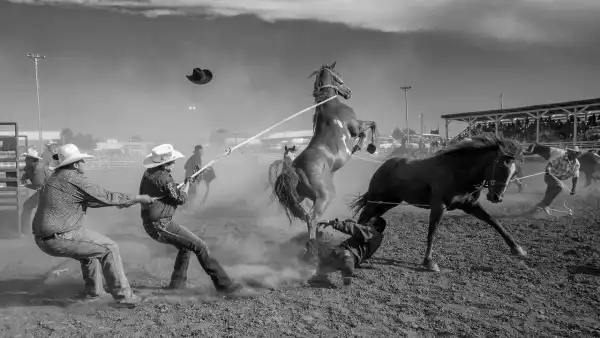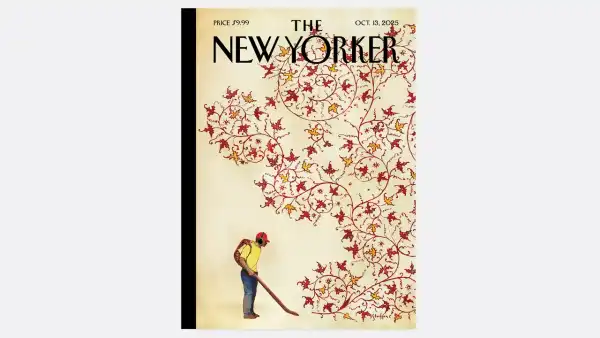
Save this storySave this storySave this storySave this story
The premiere showing of Paul Thomas Anderson’s “One Battle After Another” chiefly lays the groundwork for the joy of future viewings. Clocking in at two hours and forty-one minutes, the picture is crammed with dynamic, complex activity and sophisticated conversation, with the editing rapidly jumping between its wide-ranging collection of locales, occurrences, and figures. During my initial viewing, I struggled to comprehend the narrative—yet that sensation of lagging behind was heightened by a deficiency in psychological understanding, a feeling that the characters were mobilized purely because the script dictated it, rather than from genuine dramatic reasoning or internal motivation. Upon a subsequent viewing, I ceased to fret: being familiar with the unfolding events, I could better appreciate the particulars. The storyline’s progression became as captivating as the narrative itself, the behavioral intricacies as stirring as the plot’s own progressions. The sense of randomness that previously puzzled and irritated me was superseded by enthusiasm and unadulterated aesthetic delight.
Anderson, who penned and helmed the movie, minimizes psychological depth, crafting characters that are essentially symbolic representations. This results in a picture that, in spite of its intensely authentic and instinctively physical action, stands as a work of considerable symbolic artistry. Intriguingly, the movie is markedly dialectical in its nature—comprising numerous strata that don’t unite or connect but bounce off one another, fostering tension. In the midst of these inconsistencies, voids, discords, and contradictions, an overriding coherence takes shape.
If the subject were commonplace or insignificant, the methodology would amount to nothing more than a series of escapades. However, this narrative carries significant political weight. Situated in an alternative rendition of the United States, it centers on leftist insurgents, the government’s largely triumphant endeavors to neutralize them, and the enduring repercussions—both intimate and collective—of the revolt. Anderson sometimes undermines the principled fervor inherent in forceful, aggressive defiance, but his depiction of ruined existences and connections, as well as an American society rocked to its foundations, is anything but trivial. Moreover, by dramatizing the potent shifts in his conceived history, including its alternate present, he peers far beyond the immediate boundaries of his storytelling to attain powerful perceptions regarding the current era’s horrors. The motion picture illustrates the extreme corruptions of authority and the kinds of insight that might offer a beacon of hope (however sentimental that idea may appear), even if distantly.
“One Battle After Another” starts abruptly with two rebels—Perfidia Beverly Hills (Teyana Taylor) and Pat Calhoun (Leonardo DiCaprio), known as Ghetto Pat and Rocket Man—joining fellow members of their dissident band, the French 75, in an armed assault on an immigration detention center near the U.S.-Mexico boundary. While managing to free roughly half of the detainees, the group also reveals its existence and goals: this turns out to be merely the first in a string of offensives. The French 75 detonates a campaign office belonging to a senator who endorsed an abortion prohibition; it detonates a financial institution; it detonates a transmission tower. (Anderson portrays, with a detached sense of awe, the lights extinguishing across the metropolis it serves.) Their rebellion is also carnal, or sexualized: when Perfidia storms into the tent of the detention center’s commanding officer, Captain Steven J. Lockjaw (Sean Penn), she commands him to arouse himself, and, with that tentpole prominently visible beneath his sleepwear, escorts him out. In the vehicle returning from the raid, Perfidia and Pat become intimate; while Pat is educating Perfidia on the intricacies of explosives manufacture, she sits astride him and starts a sexual encounter; as they flee from the transmission tower where they’ve set explosives, she desires them to engage in sexual activity outdoors just before it detonates. Brandishing an automatic firearm for shooting practice, she declares to a female comrade, “Pussy ain’t for fun. This is the fun. The guns is the fucking fun.”
The sexuality is additionally racialized: early in the film, Perfidia, who is Black, questions Pat, who is white, regarding his preference for Black women. When she instructs Lockjaw, also white, to become erect, he has just referred to her as “sweet thang.” And, in a crucial juncture, Lockjaw apprehends Perfidia but pledges to release her if she consents to meet him in a motel room. She complies, concealing the encounter from Pat, and becomes pregnant, uncertain of the father’s identity. She and Pat christen the infant, a girl, Charlene, and Pat ultimately raises her independently, after Perfidia is captured, betrays the group, and enters witness protection. Pat and Charlene are issued false identities and flee. Sixteen years later, they reside together in a sanctuary city called Baktan Cross; Charlene, now called Willa (and portrayed by an exceptional young actress named Chase Infiniti), is in secondary school, and Pat, now named Bob, dedicates himself solely to narcotics, alcohol, and idleness. Suddenly, Lockjaw, now a colonel, is driven to capture Willa and pursue Bob, and the film subsequently centers on the motivations behind his pursuit, the efforts of Bob and Willa to dodge capture, their ensuing estrangement, and their courageous struggle to reunite.
A defining feature of timeless movies concerning radical action during periods of actual upheaval—such as Michelangelo Antonioni’s “Zabriskie Point” and Robert Kramer’s “Ice”—is discourse. The requirements, both ideologically and pragmatically, for organizing a collective to embark on aggressive action are compelling, as they are inseparable from the fundamental energy that imparts the drama with its emotional resonance—the shift from zeal into deeds. “One Battle After Another” lacks any of this. In Anderson’s film, partisanship, philosophy, principles, rationales are all unimportant, causing French 75’s actions to occur in an intellectual emptiness. Revolution is presented as a given rather than an achievement, more akin to a social gathering than a military force. The political landscape that Anderson illustrates in the movie’s opening acts is primarily atmospheric. Nonetheless, the film’s atmosphere isn’t completely insignificant, given its unnerving resemblance to the current sentiment. Despite the dearth of precise political details, the comparisons are clear: Anderson depicts police and armed forces uniting to confine nonwhite individuals in what effectively serve as concentration camps, and a stifling and conventional authority permits an official to indulge his perversion by abusing power.
While watching the initial portion of “One Battle After Another,” I recalled a scene from another exemplary film concerning leftist radicals and their revolutionary schemes: Jean-Luc Godard’s “La Chinoise.” There, a woman named Véronique (Anne Wiazemsky), a member of a Paris-based faction, incidentally encounters a philosophy instructor (the actual philosopher Francis Jeanson, acting as himself). She informs him about her group’s intentions to shut down their university via bombings; he tells her that she and her associates will be apprehended long before they accomplish it. She reminds him that, during the Algerian War, he had been sought by law enforcement—Jeanson indeed collaborated with pro-Algerian activists in France—and eluded capture. Jeanson clarifies, “Because numerous sympathizers existed among the French population. Because even those not entirely in favor of Algerian independence didn’t denounce us.” He continues: “Your action will lead to nothing if it can’t be embraced by a community, by a class.”
That exchange, and those statements, highlight the stakes involved in the sixteen-year interval between the two segments of “One Battle After Another.” If there is any mockery present in the early representation of the French 75 and its violent campaign, it stems from the notion of a vanguard that, being detached from a community, intends to instigate a revolution autonomously and ventures to steer society into significant transformations lacking even a semblance of widespread support—and through strategies that garner even less backing or empathy.
Minimal alteration has occurred, a narration states, during the sixteen years separating the dispersal of the French 75 and Bob and Willa’s confrontation with military aggression in Baktan Cross. The narration is both truthful and ironic. Undoubtedly, certain elements persist: persistent government persecution of immigrants; the Army closely cooperating with heavily equipped police forces and, under Lockjaw’s leadership, still launching violent raids; the U.S. fundamentally remaining under oppressive control by its own administration, a nation internally besieged. However, other facets have shifted. In Baktan Cross, an organized resistance exists, profoundly integrated within the community. Its leader, a martial-arts tutor, sensei Sergio St. Carlos (Benicio del Toro), oversees what he labels “a little Latino Harriet Tubman situation going on at my place.” Whenever combat forces target immigrants, coordinated protests emerge, alongside a meticulously planned escape initiative. (This sense of informal agreement contrasts with a noteworthy and representative aspect of the film: the lack of electoral processes. There are no factions, no campaigns, no addresses from Presidents or other officials, no evident link between the framework, however misused, of democracy and the nation’s lamentable state.)
The embeddedness of defiance manifests in alternative forms as well, as exemplified by the French 75, which, even after sixteen years, endures in some capacity. A former member (Paul Grimstad) now manages a guerrilla radio outlet, and, when he is abducted, local inhabitants notice and respond on the broadcaster’s behalf. The collective itself seems to have evolved into a rescue enterprise rather than a group of fighters: the endeavor to safeguard Willa from Lockjaw is spearheaded by another veteran member named Deandra (Regina Hall), and a large compound of heavily armed activists exists, apparently operating another form of sanctuary. They have discovered a means of connecting with the community’s sympathies and, consequently, securing aid and patronage.
One of the film’s finest moments showcases Bob, after an arrest, receiving secret support from numerous unexpected sources: several guiding inquiries, a nod or shake of the head, a piece of sagacious advice, some audacious behind-the-scenes communications, and he is freed. The scene epitomizes the rarefied aestheticism with which Anderson translates the turbulent and large-scale drama onto the screen. If modern cinema is defined by the abstract relationships between a narrative and its conveyance, the apex of classicism comprises tangible relationships rendered through style. Anderson demonstrates a classicism that is both intensely conscious and capable of extracting immense potency from a striking phrase or gesture, an inventively framed shot, even a captivating prop or item of attire. “One Battle After Another” is a remarkable action picture—not just for its tightly wound suspense, its gut-level thrills, and its compelling rooting interest but, specifically, for the exuberant inventiveness with which details are employed, moment to moment, to embody the narrative.
Anderson evokes memorable inflections of speech, purposeful glances, audacious bursts of vitality, and eruptions of anger from his captivating ensemble, making “One Battle After Another” a spectacle of inspired and committed acting. Simultaneously, certain performances—notably Penn’s but, at times, even DiCaprio’s—border on satirical exaggeration. Anderson establishes his antagonists with a fitting hint of mockery, the inadvertent buffoonery of ignorance and conceit, even as he bestows his protagonists, flawed though they may be, with a gaze of admiration. Nevertheless, strangely and disconcertingly, because military and governmental accoutrements are so commonplace from other pictures and, therefore, easily adopted by this one, Lockjaw seems more firmly rooted in his political environment than Pat/Bob and Perfidia are in theirs. Consequently, “The Big Lebowski,” in its bizarre yet learned comedy, more effectively reveals and moves in its portrayal of shattered idealism, of a former radical degenerated, than Anderson’s movie achieves.
Despite the remarkable richness of the sensory and dramatic texture of “One Battle After Another,” there is no concealed reservoir of experience or understanding beneath its imposing surface. Irrespective of any ethical or historical relevance attached to the prominence of political debate and analysis in films such as “La Chinoise” and “Zabriskie Point,” what matters is their documentary connection to experience. Both films were produced concurrently with political actions of the types they depict, and both films forge documentary-esque contact with real-life activists. They illustrate the practical undertakings of revolution, whereas Anderson’s movie emphasizes its emotional hardships. In so doing, he creates a motion picture that is both brilliant and vacant, an old-fashioned movie regarding the world of today (and perhaps tomorrow), a vision of hopeful possibilities that lingers unmoored from realities. Yet his film, even in its omissions, overflows with strategic ingenuity and daring, both cinematically and politically—to confront the hollow fantasies of other films with substantial ones, to combat the detrimental myths of other advocates with virtuous ones. ♦
Sourse: newyorker.com







